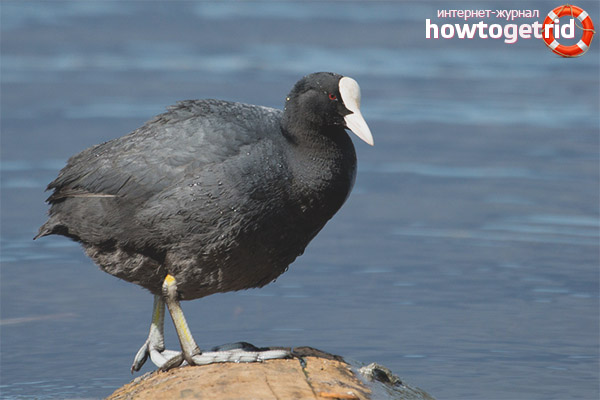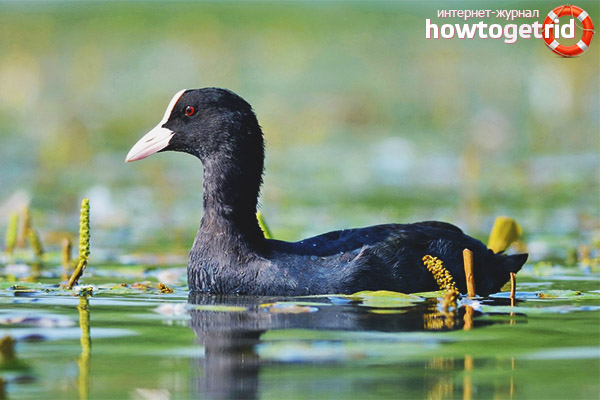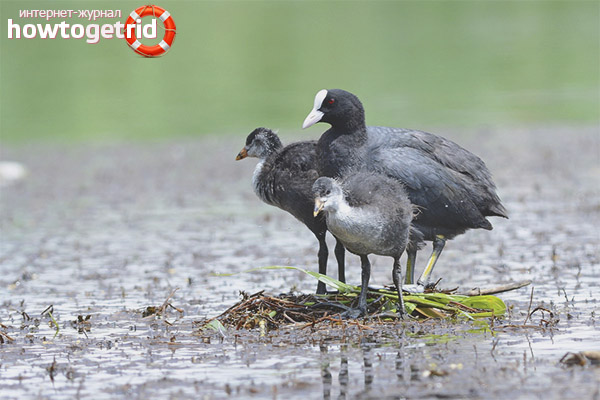The content of the article
Coot is a small, medium-sized waterfowl that belongs to the shepherdess family. Most of the inhabitants know this species under the name of flax. The coot got its original name due to the characteristic leathery spot located on the frontal part of the head, on which the feather cover is completely absent.
The main color of the representatives of this type of cowgirl is black or dark gray. The bird has a fairly long and sharp beak of white color, which smoothly passes into the above-mentioned leathery spot in the frontal part. Another feature of the coot is that it has a dark red eye color.
The feather cover of the flat is rather soft, the tail length is relatively small. The structure of the paws of this bird deserves special attention. Despite the fact that the coot belongs to waterfowl, nevertheless, on its paws there are no connecting membranes connecting the fingers to each other. Instead, scalloped lobes are present on the latter, the opening of which occurs only when the bird sits on the water surface. The main color of the paws of the coots is yellow or dark orange, the fingers themselves are dark, and the blades on them are light. This colorful combination of colors, as well as the unique structure of the paws of the flats attracts considerable attention to representatives of this species.
As a rule, coots do not have special differences in appearance between individuals, for this reason, to accurately determine the gender of birds, you should carefully listen to her voice and the sounds made. For example, females have a fairly clear voice, the sounds are loud and jerky. The male has a lower and more muffled voice, while some hissing is more predominant in the reproduced sounds.
Natural habitat
Cows are a migratory species of waterfowl, so they regularly migrate to the warm regions during the winter season. The flight time of flocks of coots is from the beginning to the end of autumn; birds return to the place of nesting from March to May.
Another feature of this species of waterfowl is that the pattern of the coot migration pathways has not yet been fully clarified, because the representatives of one population often make flights characterized by a rather long duration in completely different directions.
Many bird colonies are sedentary in Western Europe, South Asia and northern Africa, only occasionally making flights over relatively short distances.
Features lifestyle species
The bird is most active in the daytime. In the evening and at night, the activity of coots is manifested only with the beginning of the warm season and during the flight. Most of their lives, this species of waterfowl spend on water. Note that this species of birds of the shepherdess family is kept on the water surface several orders of magnitude better than all its relatives. Nevertheless, on land these birds do not move as quickly and deftly as on water.
Having sensed danger, a flax would rather throw itself into the water and dive or hide for some time in thickets of thick grass than decide to take to the air. Representatives of this type of cowgirl dive deep enough - up to 4 meters (in an upright position).Nevertheless, they practically cannot move under water, which is why they do not prey on underwater inhabitants.
In flight, the coot is quite difficult, but this does not stop her from flying fast. In order to rise into the air, the bird must first accelerate on the water surface, having run about 10 meters against the direction of the wind.
Coots are very gullible and peaceful birds, despite the fact that this species is hunted, these waterfowl very willingly let people in.
During the spring migration to the nesting site, coots prefer to make their flights in the evening and at night. As a rule, such flights are made by small groups of birds. On the contrary, they take the place of hibernation - they gather in rather large flocks, the number of which is very high (up to several hundred thousand).
Power Features
The basic diet of waterfowl such as coots mainly consists of plant foods (fruits and seeds of plants growing on water, young shoots). Most often, food is readily available vegetation, common in nesting sites of representatives of this species (algae, duckweed).
In addition to vegetable, flax also uses animal food, however, its amount in the diet of poultry is about 10% of the total mass (small fish, invertebrates, mollusks and eggs of other birds). It has been observed that coots often get their own food, simply taking it away from swans and other duck species, even though the latter are often much larger.
Propagation Features
Coot ducks are monogamous birds. Having reached the age of puberty, as a rule, individuals immediately form a pair. I would like to note that the breeding period of this species of waterfowl does not differ in constancy and directly depends on many different factors - starting from weather conditions and ending with the availability of the necessary food in the nesting area. Basically, the beginning of the mating season coincides with the time of arrival of birds after the winter.
During the mating season, the birds behave not only very actively, but also noisily, often show some aggression in relation to their potential rivals, who are also interested in a certain female. After the pair is selected, the males look after their mate, which is manifested by the mutual cleaning of plumage and feeding the food obtained. At the next stage, a couple of birds is engaged in the construction of their nest, while their behavior changes dramatically - they behave as discreetly as possible so as not to attract too much attention from birds of prey and animals that can ruin the nesting area.
Directly, the nest itself is built by coot on the surface of the water, in dense thickets of vegetation, which allows it to be carefully masked.
During the construction of the nest, the latter is fixed by birds on the water through the root system of underwater plants. This is done so that the current does not take away the bird house. As a rule, the diameter of such a building reaches 35-45 cm, the depth is at least 20-25 cm. The distance between the coot nests is at least 30-50 meters.
When other species appear near the nesting site, coots often attack an uninvited guest. In some cases, to repulse the attacks of their enemies, the birds are combined in small groups, which helps protect the nests from ruin.
During one season, a female flat can lay several egg clutches, while the number of eggs in one clutch reaches 10-12 pcs. Eggs of the correct form, light sand color with brown specks.
Already after the first day after hatching, coot chicks can leave the nest with their parental pair. During the first two weeks, adults help the chicks by teaching them vital skills and getting food for them.
Three-month-old chicks of flats are already quite strong birds that can independently get food and fly. As a rule, upon reaching this age, young representatives of the species stray into small flocks and prepare to fly to the place of the first wintering.
This type of migratory waterfowl such as coot is a game desirable for any hunter. Often, special stuffed animals are used to bait this bird during hunting, which attract waterfowl and peace birds.
Video: coot (Fulica atra)












Submit